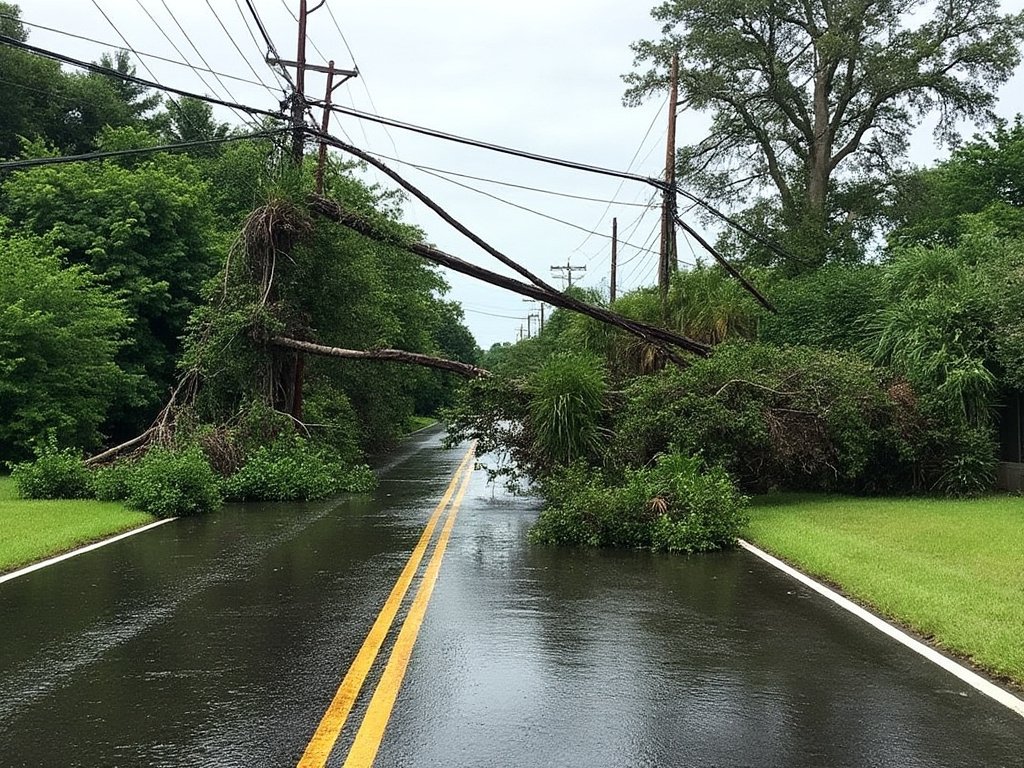On October 9, 2024, Hurricane Milton—a powerful Category 3 storm—slammed into Florida’s west coast near Siesta Key. With winds reaching 120 mph and torrential rain, it left a path of destruction from Tampa to Sarasota. Though the storm didn’t directly hit Miami, its effects were felt across the region, leading to localized flooding, power outages, and a city in recovery mode.
As a journalist based in Miami, the city braced for the worst, much like in past storms, with residents securing their homes, stocking up on essentials, and anxiously awaiting the storm’s track. Fortunately, Milton veered slightly north, sparing Miami from its full wrath. However, the storm’s outer bands brought heavy rains and wind gusts, especially impacting coastal areas like Brickell and Coconut Grove, where flooded streets made navigating the city difficult for several days.
The Arrival of Milton: From Tropical Storm to Hurricane
Hurricane Milton developed rapidly in the Gulf of Mexico, initially forming as a tropical depression on October 5. By October 7, the storm intensified, reaching Category 3 status, causing forecasters to issue urgent warnings for Florida’s Gulf Coast. Residents in coastal cities, already weary from Hurricane Helene weeks earlier, scrambled to prepare once again.
As Milton moved closer to the Florida coast, meteorologists emphasized the potential for a deadly storm surge, along with hurricane-force winds capable of toppling trees, damaging buildings, and knocking out power. With many residents fearing a repeat of past storms, thousands evacuated, and many more prepared for the worst.
Miamians, familiar with the hurricane season drill, were on high alert, recalling the devastation left by previous storms like Irma and Andrew. Despite missing the direct impact, the storm caused enough anxiety to empty supermarket shelves, fuel gas station shortages, and pack public transportation hubs as people prepared for the worst.
Miami’s Brushed Impact
Although Miami escaped the full force of Hurricane Milton, it didn’t come through unscathed. Strong wind gusts, coupled with torrential rain, resulted in localized flooding in vulnerable areas. Brickell and Coconut Grove experienced streets turning into rivers, reminiscent of previous hurricanes that overwhelmed the city’s drainage systems. Power outages affected thousands of homes across Miami-Dade County as downed power lines caused temporary blackouts.
Florida Power & Light (FPL) dispatched crews to restore electricity as quickly as possible, prioritizing essential services like hospitals. In less affected areas, power was back within a few days, but the worst-hit neighborhoods faced a longer wait. The storm served as a sobering reminder of Miami’s ongoing vulnerability to extreme weather events, especially as climate change continues to exacerbate these conditions.
With floodwaters receding, Miami’s recovery efforts kicked into high gear. City workers cleared debris, while residents in more affluent areas began to assess damage to their homes. In more flood-prone neighborhoods, recovery could take weeks. Although the storm wasn’t as devastating for Miami as anticipated, its outer bands still caused structural damage, reminding residents that any hurricane, no matter its direct path, brings its share of destruction.
Statewide Response and Emergency Measures
Florida’s preparation for Hurricane Milton began days before its landfall. Governor Ron DeSantis declared a State of Emergency across 51 counties, allowing FEMA and local authorities to pre-position resources like food, water, and medical supplies. Local governments issued evacuation orders for vulnerable coastal areas, particularly along the Gulf Coast, where storm surges were expected to reach dangerous levels.
Evacuations saw major highways clogged with traffic, and many residents faced fuel shortages due to panic-buying. To mitigate these challenges, tolls were suspended along evacuation routes, and public transportation was expanded to help people reach safer areas. By the time Milton hit, shelters were already filled with evacuees, and emergency services were deployed across the state to handle the expected chaos.
In Miami, Mayor Francis Suarez took a proactive stance, urging residents to prepare regardless of the storm’s projected northward shift. The city’s emergency services worked in tandem with state agencies to ensure evacuation orders, if needed, could be executed efficiently. While Milton didn’t cause widespread devastation in Miami, the city’s comprehensive preparation measures showed a readiness to handle future storms, even as the unpredictability of hurricanes grows.
Aftermath: Recovery and Resilience
Florida’s recovery from Hurricane Milton is now well underway, with FEMA leading the charge in providing financial and logistical support. For areas like Tampa and Sarasota, where the storm surge caused widespread flooding and wind damage, FEMA is working closely with state officials to ensure aid is delivered quickly. Debris removal, the restoration of power, and infrastructure repair are the immediate priorities, but the full recovery process could take months.
In Miami, where damage was less severe, the focus remains on restoring power, clearing roads, and helping residents affected by the storm’s flooding. Neighborhoods like Brickell and Coconut Grove are no strangers to cleanup efforts, and many community-led initiatives have already sprung into action. Volunteers, local businesses, and city officials are working together to support those displaced by the storm, with donation drives and assistance centers set up in key areas.
The resilience of Miami’s residents shines through in the aftermath of each storm, and Milton is no different. While the damage may not compare to more direct hits in Florida’s history, the storm served as a reminder of the ever-present risk of living in a hurricane-prone area. Conversations around climate change, storm preparedness, and infrastructure improvement are once again at the forefront, especially as residents brace for what could be an increasingly active hurricane season.
Looking Ahead: Preparing for the Next One
As Floridians take stock of the damage from Hurricane Milton, the realization that this won’t be the last storm looms large. Experts warn that climate change is making hurricanes stronger and more frequent, and Milton could be a harbinger of storms to come. For Miami, this means continued investment in flood prevention infrastructure, like improving drainage systems and strengthening building codes to withstand stronger storms.
For many, Hurricane Milton is a reminder of the unpredictable nature of hurricane season. With several weeks left in the 2024 season, residents must remain vigilant, knowing that another storm could develop at any time. The city’s resilience and preparedness are its strengths, but the increasing frequency of severe weather events adds urgency to conversations about long-term climate adaptation.
Recovery from Hurricane Milton may take time, but the efforts being put forth now are laying the groundwork for a more resilient future. From federal aid to grassroots community support, Florida is coming together once again to rebuild. As residents repair their homes and lives, one thing remains clear: Florida’s strength lies in its people and their ability to recover, no matter how many storms they face.
FAQs
When will power return?
Power restoration efforts are already underway, with priority given to hospitals, emergency services, and essential infrastructure. In less affected areas like Miami, power should return within a few days, but in harder-hit regions like Tampa, it may take up to a week or longer.
How will FEMA help?
FEMA is providing financial assistance for temporary housing, home repairs, and personal property replacement. They are also working with state and local agencies to deliver essential supplies, assist with debris removal, and support long-term recovery efforts.
When will schools reopen?
School reopening will depend on the extent of damage. In less affected areas like Miami, schools could reopen within a few days. In heavily impacted areas, schools may remain closed for at least a week or longer as damage assessments and repairs continue.
How will roads recover?
Road recovery will involve clearing debris and fallen trees, repairing damaged infrastructure, and reopening essential routes. Hard-hit areas may take weeks or months to fully recover, but temporary fixes like detours and opened road shoulders will be used to ease congestion.
What’s next for recovery?
Recovery efforts will focus on restoring power, clearing debris, and rebuilding infrastructure. FEMA will work closely with state agencies to provide financial aid, while local governments will continue to assess damage and coordinate long-term rebuilding.
How long will rebuilding take?
Rebuilding could take months, especially in areas that suffered severe damage. However, immediate recovery efforts like power restoration and debris removal should be completed within weeks. Long-term rebuilding will focus on enhancing resilience against future storms.





